Cruisers of the Chapaev type. 3 Part: Post-War Modernization
So, we see that the cruisers of the 68 project should have been at least one of the best (or rather the best) light cruisers of the world. But they were unlucky - the seven ships, laid down in 1939-1941, were in no way able to get into service before the start of World War II, and there their construction turned out to be frozen. Of course, when the question of their completion arose, the sailors wanted to take into account as much as possible the military experience acquired at such a high price.
However, in fairness, it should be noted that even before the start of the war, various options for adjusting the project 68 were considered. Having fears that domestic developers of artillery systems will once again delay the delivery of the main and anti-aircraft caliber the fleet, and taking into account the temporary warming of relations between the USSR and fascist Germany, the People's Commissar of the Navy N.G. Kuznetsov in July 1940 approved the TTZ for the re-equipment of one cruiser with German artillery and the OMS. The project received the naming 68I ("foreign"). It was supposed to install twelve German 150-mm guns (apparently, it was a 150-mm / 55 SK C / 28) in the German towers and replace the two-gun 100-mm B-54 towers with 105-mm LC / 31 deck-mounted units. This installation was originally created under the 88-mm gun and had separate vertical guidance of the trunks. Subsequently, the Germans moved away from this, “laying” both 105-mm guns in one cradle, thereby achieving a weight saving of 750 kg, and the new installation was called LC / 37. It was already being produced at the time of the negotiations, but, apparently, in this case the Germans preferred to equip their fleet with them, rather than selling to a potential enemy.
However, the question of 150-mm German guns was dropped at the end of 1940. First, it turned out that there were no such guns, towers and FCS for them in the metal, and they would have to wait for their production, which completely made the deal meaningless. It was believed that the domestic B-38 and MSA should get better than the German ones, and the delivery time was comparable. And besides, the very first calculations showed that the German equipment was significantly heavier than the Soviet, requiring more space and electricity, as a result of which the light cruiser displacement had to increase by 700 tons, which was also considered unacceptable.
So, the German main caliber was abandoned almost immediately, but another thing is the 105-mm universal. Here, the gains from the acquisition were unquestionable, including the fact that the German installations were stabilized, but we still did not know how to do this. In addition, the replacement of the B-54 by LC / 31 had practically no effect on the ship’s displacement, since the mass of the installations was comparable. Therefore, it was decided to purchase four such installations together with two fire control posts and install them on the Valery Chkalov pledged to 31.08.1939.
True, this did not end with anything good, because the Germans still did not deliver anything, and the Soviet shipbuilders had to make changes to the project, because of which Chkalov’s launch was delayed.
An even more radical version of the initiative was the TsNII-45 - the light cruiser Chapaev was supposed to be ... a small aircraft carrier: 10, 500 and displacement, 33, 30-32 and even two catapults. However, work on the domestic aircraft carrier in those years did not receive development.
The first “Preliminary TTZ for the adjustment of the project in relation to the mothballed ships of the 1 series, based on the conclusions from the combat experience of the Navy ships in the current war” was issued in September 1942, the second - in March 1944. armament light cruisers. The number of 100-mm guns should have been brought to 12, and instead of the initially planned four two-gun B-54, now six new stabilized C-44 units were required. Instead of six 37-mm X-pairs of 66-K, it was necessary to install twenty newer B-11, thereby increasing the number of 37-mm trunks from 12 to 40! In another version, it was proposed to install only a dozen B-11, but they should be supplemented with four quad 23-mm installations 4-У-23 (created on the basis of the air gun VY).
Designing the 68 cruisers, the TsKB-17 carried out the relevant studies, but it was not possible to put down such firepower, retaining the four MK-5 three-gun turrets of the main caliber. As a result, the specialists of TsKB-17 offered their own version of a radical reorganization of the cruiser artillery armament. The designers guaranteed the placement of not even 12, but 14 100-mm ZKDB and 40 cannon barrels of 37-mm machine guns, but on condition that a dozen 152-mm guns were replaced with nine 180-mm guns in three MK-3-180 guns. And then the fun begins.
The aforementioned proposal of TsKB-17 was heard in 1944 g, when all the features of the operation of the domestic 180-mm artillery were identified and taken into account. And there is no doubt that if our 180-mm B-1-P were a completely worthless weapon, which many modern sources like to describe it, the fleet would immediately refuse such a proposal. However, the General Directorate of Shipbuilding supported TsKB-17, and the Operational Directorate of the Main Naval Staff noted that the replacement of the MK-5 with the MK-3-180 with the above-described strengthening of anti-aircraft weapons:
The return to the 180-mm caliber is certainly very interesting. In the first article of the cycle, we described in detail why the 152-mm guns were much more consistent with the tasks of the 68 cruiser compared to the 180-mm caliber, and suddenly ... But in reality there is no contradiction here. The fact is that the 152-mm guns were larger than the 180-mm guns for the squadron service, and we were going to build a large fleet - but at the end of the war, in 1944-45, it was quite obvious that no such fleet would be we will not have time. Back in 1940, the construction of heavy warships was significantly limited: by order NKSP No. 178 of October 22 1940 g based on the decision of the Government of the USSR "On the plan of military shipbuilding for 1941 g" plans to create a large fleet were largely curtailed.
Thus, out of six battleships under construction and heavy cruisers, it was necessary to concentrate on completing only three (the battleship Soviet Russia, the heavy cruisers Kronstadt and Sevastopol), the construction of two battleships should be “limited” and one more - Soviet Belarus - disassembled on the stocks. But the construction of light cruisers was supposed to continue - followed by the end of 1941 g to lay more 6 light cruisers of the project 68. As for the post-war programs, they have not yet been compiled, but it was clear that a war-weary country could not immediately begin building an ocean fleet. Thus, it appeared that the light cruiser would become the main ship of the Soviet Navy for the coming years, while there would be no “squadron” in which it was intended to serve. And this returned the fleet, if not to the theory of a small naval war, then to actions against the superior forces of the enemy fleet on our shores, for which the 180-mm caliber was better suited to six-inch guns. Well, given the fact that the required anti-aircraft defense could only be ensured when 180-mm guns were placed on the ship, the TsKB-17 variant was indeed optimal.
Nevertheless, Chapaev-type cruisers did not receive the MK-3-180, but for non-tactical reasons, but of a production nature: it was possible to resume production and ensure delivery of 180-mm guns and turrets a year later with 152-mm B-38 and MK -5. As expected, it will push the launch of the newest light cruisers, while they were required by the fleet extremely urgently.
As a result, the modernization of the 68-K project was much more “sparing” in nature: its main areas were the enhancement of anti-aircraft weapons, although not to the extent originally planned, the second was to equip cruisers with radars of various kinds. The remaining decisions, for the most part, were the result of the above.
The ranged anti-aircraft caliber was now represented by four two-gun 100-mm units SM-5-1., And it must be said that this artillery system provided everything that local anti-aircraft gunners could dream of during the war years. Externally, the CM-5-1 was very similar to the German 105-mm unit LC / 37, they had a lot in common: the one and the other units were stabilized; both had remote control, i.e. the angles of vertical and horizontal pickup could be installed directly from the command-range point (in the CM-5-1, the D-5С system was responsible for this), with both guns placed in the same cradle.
But there was a difference - the German installations were deck, and domestic CM-5-1 - tower. Of course, they were not fully automated, but still the delivery of shells to the fighting compartment with the help of elevators looked much more progressive - the calculation needed only to shift the shot to the swinging tray, the remaining operations were performed automatically. In addition, the calculation was covered from the fragments. The weight of the projectile of the Soviet art system is not significantly higher - 15,6-15,9 kg versus 15,1 kg German, but the initial speed (1000 m / s) exceeded that of the German woman on 100 m / s. The speed of vertical and horizontal guidance of the CM-5-1 was also higher than the German one - 16-17 deg / sec versus 12 deg / sec.
Two SPN-200-RL controlled the ZKDB fire, each of which, in addition to the optical observation means, had its own radar Vympel-2. In addition, each installation of CM-5-1 was supplied with its own “Range-B” radio range finder. Of course, not everything worked out right away - the same "Vympel-2" turned out to be an unsuccessful radar, which in the end was "degraded" into radio rangefinders. But unable to provide support for air targets in three coordinates. However, in the course of subsequent upgrades (the beginning of the 50-ies), more sophisticated radar "Anchor" and "Anchor-M" were installed on ships, thanks to which for the first time in the USSR it was possible to solve the problem of combining anti-aircraft artillery firing method with automatic tracking (in three coordinates) air targets.
As for ammunition, SM-5-1, along with high-explosive and high-explosive fragmentation ammunition for firing at sea or coastal targets, used two types of anti-aircraft missiles: containing 1,35 kg XZUMX 55 kg and equipped with a set of 4-gauge; more weight (15,6 kg), but, alas, a significantly lower content of explosives - only 55 grams. In addition (possibly due to the mass difference), the initial speed of the ES-15,9Р is 816 m / s lower and is 55 m / s. Unfortunately, the author of this article was not able to find out the date of receipt of this projectile in service.
In general, we can say that the CM-5-1 and the universal artillery fire control system used on the 68-K cruisers brought it to a completely new level compared to the original, pre-war version.
Test SM-5-1 on the light cruiser "Chapaev"
With 37-mm automata, the situation has also improved significantly. Although instead of 20 installations, we had to limit ourselves to fourteen, but the new B-11 machines were very successful. Their ballistics corresponded to 70-K, with which our fleet went through the whole war, but unlike their “ancestor” B-11, they received water-cooled barrels, which approximately doubled the number of shots that the machine could make before the critical overheating of the barrel. B-11 guidance is only manual, but the installation has been stabilized. Unfortunately, the reliable stabilization of such automata turned out to be too tough for the domestic industry, so it was usually turned off during service. Own KDP at anti-aircraft guns ... as if there was no, although the presence of some kind of STS "MZA-68K" is mentioned, although the author did not manage to find what she was. But it is reliably known that the STS Zenit 68K, controlling the fire of the universal 100-mm artillery, also issued target designation for anti-aircraft guns. It is not entirely clear how effective target designation could be at that technological level, but nevertheless it should be noted that, in contrast to optical means (stereo-distance meters), one radar can observe and control the movement of several targets. At the same time, it is reliably known that the main caliber PUS of the 68-K cruisers of the project could provide simultaneous firing at four different targets.
Installations B-11 on the Chapaev light cruiser
There were no other anti-aircraft weapons on the ships of the 68-K project - they refused from anti-aircraft 12,7-mm machine guns due to low combat effectiveness.
As for radar weapons, it was planned to be quite diverse for Chapaev-type cruisers: according to the original plan, it was supposed to set up radar control of surface ("Reef") and air ("Huis") situations, but this did not exhaust their capabilities. For example, “Reef” could detect targets like “cruiser” at a distance of 200-220 kb, a “torpedo boat” - 30-50 kb, spikes from falling 152-mm high-explosive or fragmentation shells - from 25 to 100 kb, and could be used issuing target designation artillery main caliber. Huyus-2, although it was considered to be surveyed, capable of detecting a flying plane, starting from a distance of 80 km, could also provide a command center for universal artillery.
In addition, of course, there were also artillery radars - for controlling the 152-mm artillery fire, two Redan-2 radars were used, which were located on the roofs of both control towers. Redan-2 carried out all the necessary measurements, determining both the distance to the target and the distance to the bursts from falling projectiles and the distance between the target and the bursts. Unfortunately, these radars also turned out to be not too good, and at the beginning of the 50-s were replaced with a new “Zalp” radar, which coped well with its “duties”. In addition, the elevated turrets of cruisers received a “Shtag-B” radio range meter capable of “seeing” a “destroyer” target with 120 kb and tracking a goal starting from a distance of 100 kb, while the error in determining the distance did not exceed 15 meters. The lower towers did not receive the “Shtag-B”, apparently, because the muzzle gases of the towers No. XXUMX and 2 could damage them when firing on sharp bow (stern) corners.
How effective was the domestic radar weapons? In this regard, the shots that took place on 28 in October of 1958, in which the Kuybyshev and Frunze cruisers took part, are very indicative. The shooting was carried out at night and exclusively according to the radar, the shield towed the destroyer of the project “Exuberant” 30-bis, which was completely shaded so that the cruisers could not use optics to observe the towing vehicle.
Going at speeds above 28, the cruiser’s bonds detected the target from a distance of 190 kb and formed the combat course, and when the distance was reduced to xnumx kb, they began to fire. The Kuybyshev launched two sighting volleys, waited for the shells to fall, fired another third sighting volley, and then both cruisers opened fire to kill. The shooting continued for 131 minutes (unfortunately, it is unclear at the source whether the 3 lasted a minute to kill or all shooting, including sighting) and ended when the target shield was separated from the 3 kbt cruisers. The target hit 117 projectile, including two in the cloth and one - in the body of the shield. The command rated the shooting as “excellent”, and we have no reason to lower the estimate obtained by the cruisers - for such distances and relatively light 3-mm guns, this is really a brilliant result.
If we are talking about the main caliber, we note that the management of a dozen 152-mm guns was assigned to the new PUS "Molniya-ATs-68K", which represented a significant modernization of the "Lightning-AC", which stood on the 26-bis cruisers, including the capable to fully take into account the data provided by the radar, combining them with the data of optical observation devices. Duplication of fire control systems would, perhaps, make even German heavy cruisers like the Admiral Hipper blush with envy. The Chapaev-type ships had two shooting machines, two backup shooting machines and four turrets (in each turret).
The radar armament of cruisers was constantly improved. For example, starting from 1958 g, the radar station of the air situation survey on all cruisers (except Frunze) was replaced with a new one — Fut-B, as a result, the detection range of the aircraft increased from 80 to 150 km. And in general, it can be stated that the 68-K cruisers possessed fairly modern radar equipment, which was quite adequate for the tasks facing this type of ships.
Of course, the list of new equipment was not limited to radar and anti-aircraft weapons and PUS alone. For example, ships received a wider range of radio stations and receivers, the Burun-K radio direction finders, the Tamir-5H hydroacoustic station, but the most interesting innovation was the equipment of the combat information post Zveno. Surprisingly, the fact is that in 1949, the SRI-10 developed a prototype of modern automated control systems and was designed to coordinate the work of the ship’s means of lighting the surface and air situation and reflect it on special tablets and — most interestingly — to target their own aircraft and torpedo boats. The “Link” equipment was capable of simultaneously processing data on 4-5 surface and 7-9 air targets, directing a group of fighters at one air target and two groups of torpedo boats at one surface target.
But all these advantages of modernized cruisers were bought at a very high price. It was necessary to abandon aviation and torpedo armament, but even with this in mind, the overload reached 826 t, as a result of which the standard displacement was 11 450 t., The draft increased by 30 cm, the reserve of combat survivability and longitudinal stability decreased, although, in fairness, it should indicate that even in such a state, the ship retained superiority over these indicators over the cruisers of the 26 and 26-bis project. Full speed dropped to 32,6 knots (when forcing 33,5 knots). It should be noted that, despite the overload of the cruiser, they managed to surpass the design task in terms of the cruising range. The range at the maximum fuel reserve during the economic course of the project was supposed to reach 5 500 miles, but in fact it ranged from 6 070 – 6 980 miles to cruisers.
The height of the freeboard was still insufficient - even with 4-5 ball waves, when moving against a wave, the optics of the 152-mm nasal towers were splashed and flooded, the wallpaper of the stabilized B-11 automatic weapons posts located in the nasal superstructure.
But the most unpleasant was the explosive increase in crew size - after all, all the additional weapon and equipment required personnel for their service. Initially, according to the pre-war project, the crew was supposed to make 742 man, but during the post-war redesign of the ship, this number should have increased by almost 60% - up to 1 184 man! As a result, it was necessary to simplify the equipment of the premises, eliminate the lockers (!), Use three-tier collapsible beds for the team, while the bed nets were stored outside the premises - there was simply no space inside. In addition, if the officers still had a mess room, the sailors were forced to be content with a tank meal in the cockpit. On the other hand, one should not think that the designers forgot about the crew altogether - the “Chapayevs” were distinguished by a developed “communal” infrastructure, including large reserves of fresh water and provisions, refrigeration units, adequate medical and bath-laundry units, etc. A similar problem was observed on American light cruisers of the “Cleveland” type - with a similar standard displacement, the crew size was 1 255 people and living conditions were perhaps the worst among all American cruisers.
In addition, the cruisers of the 68K project also had other drawbacks that were not so obvious but unpleasant in everyday operation. For example, the electric power system operated at a constant current, which for 50's was considered an anachronism, there were no active pitching dampers, there was no system for collecting and purifying water, and the cruiser was simply forced to drain all the dirt into the sea, which created certain difficulties as when returning in their own, and when entering into foreign ports. The ships of the 68K project were distinguished by an increased level of noise (including because of the need for powerful ventilation systems for the increased crew), the lack of a wooden covering of the upper deck and the side of the forecastle made it difficult for personnel to work on them. It seems to be the little things - but overloading the ship no longer allowed me to fix anything.
It is very difficult to compare the ships of the 68K project with the cruisers of foreign powers for the simple reason that in the post-war world almost no one was engaged in the creation of classic light cruisers. What for? A large number of them remained after the war, and the situation in the world changed so much that the huge cruising fleets of the United States and England turned out to be redundant and, in general, unnecessary. The same Americans massively launched cruisers of the Brooklyn and Cleveland and even later Fargo types to the reserve. The countries lost their fleets, France was in a rather regrettable economic condition, and to build a strong fleet had neither the desire nor the capacity.
We have already compared the 68 project with the Cleveland-type light cruisers, and it can only be noted that the superiority of the 68K project in everything except anti-aircraft artillery has only increased, and in part of the anti-aircraft guns, the gap was no longer fatal. Much more interesting is the American "work on the bugs" "Cleveland" - light cruisers like "Fargo". These ships, having a displacement similar to the 68K project (11 890 t), had the weapons of the Cleveland: 12-152-mm / 47 guns, which are inferior in the firing range, but superior to domestic B-38, and also 12 * XN mm / 127 universal guns, 38 barrel 24-mm machines and 40 14-mm "Oerlikon" (paired). But if the “Cleveland” had many shortcomings, then the “Fargo” were, for the most part, spared from them, which is why they became full-fledged light cruisers. In addition, the series of these cruisers was laid at the end of 20, when the Americans were already fully armed with military experience and understood perfectly what they wanted from their light cruisers - therefore, although the “Fargo” went into service in 1943-1945, but “ Chapaevs ”- in 46, they can be considered to some extent as peers.
Since the main caliber guns and Fargo's reservation corresponded to Clevelands, they lost in artillery fighting with Chapaev-type cruisers for the reasons stated in the previous article, but I would like to note that with the advent of artillery radar for the Americans, things only got worse. Now Soviet cruisers could conduct an effective battle at a distance of at least 130 KB (as demonstrated by the 28 of October 1958 d), while for the American six-inch engines such distances were extreme in range (with corresponding consequences for accuracy and so on), so The advantage of Soviet cruisers in the increased distances of the battle was even greater than before.
It is more difficult to assess the Fargo and Chapaev anti-aircraft weapons. The rhombic position of the universal 127-mm / 38 guns of the American cruiser gave him the best firing angles, while the 8 * 127-mm trunks could act on board, while the Soviet cruiser had only 4 * 100-mm. In this case, the American projectile won at the expense of a higher content of explosives - 3,3 kg, against only 1,35 kg of the Soviet "weave", which gave the American installation a much larger radius of destruction. Obviously, there was no advantage over the shooting control devices of the Chapaevs over the Americans (although there was probably no lag either), but at the time of putting the Chapaevs into operation in the CM-5-1 artillery grabs there were no projectiles with a radio fuse . Of course, Soviet artillery installations had certain advantages - the superiority in the initial velocity of the projectile (1000 m / s, versus 762-792 m / s) made it possible to reduce the time of arrival of the Soviet projectiles, which increased the chances of hitting the maneuvering aircraft. The stabilization of the Soviet installation greatly simplified its tip-off, due to which, perhaps, the real rate of fire could be higher than the American one (this is the author’s assumption, there was no such information in the sources). But, in any case, these advantages could not compensate for the lag in other parameters listed above. Thus, the American universal battery "Fargo" looks preferable.
As for anti-aircraft guns, here the Soviet and American cruisers have an approximate equality - 40-mm and 37-mm shells had a similar destructive effect, and in general, the capabilities of the B-11 approximately corresponded to dual 40-mm "Bofors", and by the number of barrels Americans excellence was not available. Unfortunately, it is impossible to assess the difference in the quality of fire control of rapid-fire automata due to the author’s lack of data on the Soviet CCP. As for the Oerlikon, in the 50-s they were more like psychological defense.
Thus, the American light cruiser "Fargo" was inferior to the domestic 68K in an artillery battle, but had some (and not already overwhelming) superiority in air defense. Soviet cruisers had the advantage in speed, and the American cruisers had a range.
The very extravagant light cruisers of the Worchester type, which already had 6 two-gun turrets with 152-mm guns, became the same age-mate (on the day of entry into service) of the Chapaev-type cruisers. Here these ships will compare really interesting.
The Americans understood that, despite all the advantages that the magnificent 127-mm / 38 installation gave them, it is still too heavy for cruisers. Therefore, the idea of abandoning universal artillery on light cruisers was born back in 1941 g, and instead use the universal six-inch caliber. To do this, it was necessary to “quite a bit” - to ensure a significantly higher rate of fire of the guns, a large angle of vertical guidance, and, of course, a high rate of guidance, both horizontally and vertically.
The basis was taken all the same time-tested 152-mm / 47 gun, which was still on the "Brooklyn". Then they tried to create a turret installation for her that had a slightly lower rate of fire (12 rds / min versus 15-20 rds / min), but otherwise (angle of vertical pickup and vertical / horizontal speed of pickup) corresponding to 127-mm "pairing". The result is a monster weighing in 208 T (this is only the rotating part), while the Cleveland three-gun turret weighed in 173 T. Thus, the difference in weight between the rotating parts of the 4 towers of the Cleveland cruiser and 6 two-gun towers Worchester was 556 tons. Interestingly, the weight of the two-gun 127-mm Mark 32 Mod 0, which were mounted on the Cleveland and Fargo cruisers, was only 47,9 T - i.e. The six Worchester towers weighed like the Cleveland 4 turret and plus ELEVEN with half a two-gun 127-mm rig. That is, waving their hands on versatility, the Americans could get in the same weight not only 12 six-inch for naval combat, but also 22 127-mm barrel, from which, to ensure air defense, it would be much more than a dozen six-inch “ Vorchester. But most importantly, the installations turned out to be not only heavy, but also unreliable, and during operation they were constantly pursued by mechanical failures, which is why the planned rate of fire of 12 rds / min. almost never achieved.
The Worcester reservation scheme repeated Brooklyn, Fargo, and so on. with all its flaws. True, the horizontal armor is very strong, the Americans brought it to a completely unkillable for the six-inch artillery 89 mm, but here two aspects should be taken into account. Firstly, this did not cover the entire deck, and secondly, unfortunately, Americans are often inclined to overestimate the characteristics of their ships compared to the real ones (recall the same 406-457 mm armor-belt battleship Iowa, which turned out to be 305 mm ). Worchester-type cruisers are assigned a citadel of quite decent length (112 m) and thickness (127 mm) and an armored deck in 89 mm, and all this (except for the length of the citadel) significantly exceeds the domestic cruiser (133 m, 100 mm and 50 mm, respectively) . But for some reason, the weight of the Chapaev reservation is 2 339 t, and the Worchester has 2 119 t.
As many as four directors of the Mk.37 with a circular radar antenna Mk 28 were used to control the fire of the main caliber. From the point of view of air defense, it was a very good solution, but for an artillery battle with the enemy's cruiser, it was useless, since these directors were created to control 127-mm artillery anti-aircraft fire and could not work effectively on surface targets at long distances.
There was no universal artillery as such, and the role of anti-aircraft machine guns was performed by 76-mm / 50 two-gun (and on the lead ship of the series - and single-gun) installations, while the total number of guns reached 24. They were inferior to 40-mm "Bofors" in the rate of fire (45-50 rds / min against 120-160 rds / min), but the Americans managed to install radio bombs on their shells. Thus, enemy aircraft could be hit by shrapnel from a close gap, while from Bofors the aircraft could only be shot down by a direct hit. The actual combat effectiveness of this solution is unknown, but in general, the 76-mm artillery system had a greater range and ceiling, and was obviously significantly better than the usual Beaufors. The 76-mm artillery fire control was carried out by four directors Mk.56 and nine - Mk.51.
On the one hand, the number of directors of anti-aircraft fire control is impressive and far exceeds that of Soviet cruisers (who had 2 SPN and 4 radio rangefinder, one for each universal caliber turret), but on the other, in order to correctly compare the capabilities of American and Soviet PUS, need to know their capabilities in detail. It is known, for example, that the best results were achieved if one director of the United States ran the 1-2 127-mm installations, no more, but how did domestic SPN work? Unfortunately, the author does not have such data - and this is very important. The quality score of the LMS “by the heads” in this case will not be correct.
Perhaps, we can say that the Americans tried to create a fairly highly specialized cruiser, “sharpened” primarily under the air defense of the formations, and capable (in theory) to effectively repel the attacks of enemy destroyers. However, the ship’s standard displacement reached 14 700 t (which is almost 30% more than the Chapaev-class cruiser) and came close to the heavy Des Moins (17 255 t), despite the fact that the latter had a comparable the best) air defense (12 * 127-mm and 24 76-mm 76-mm anti-aircraft gun barrel), but at the same time carried nine powerful and quick-fire 203-mm guns, as well as more solid armor at the same speed. Accordingly, the air defense capabilities were significantly superior to those of the Chapaev, but in the artillery duel, ships of the Worchester type still remained vulnerable to Soviet cruisers.
Light cruiser "Chapaev" in the Kola Bay
In general, the following can be said about the modernized 68K project. The pre-war 68 project turned out to be quite good and had good reserves for modernization, but the need to install advanced radar and anti-aircraft weapons based on the results of military experience led to the complete exhaustion of the modernization potential of Chapaev-type cruisers. Of course, the air defense capabilities of the cruisers grew almost an order of magnitude compared with the original project, but still did not meet the sailors' wishes (12 * 100-mm and 40 * 37-mm trunks). The cruisers of the 68K project turned out to be quite modern ships at the time of their entry into service, but they still had a number of drawbacks, which, alas, could not be eliminated due to the limited size of the ships of this project. The 68K cruisers were very timely commissioned - the Soviet post-war fleet desperately needed ships, and at first the Chapaev’s capabilities met the fleet’s tasks, but there was no point in resuming further laying of ships of this type - the fleet needed a more modern cruiser.
But it is already completely different. story...
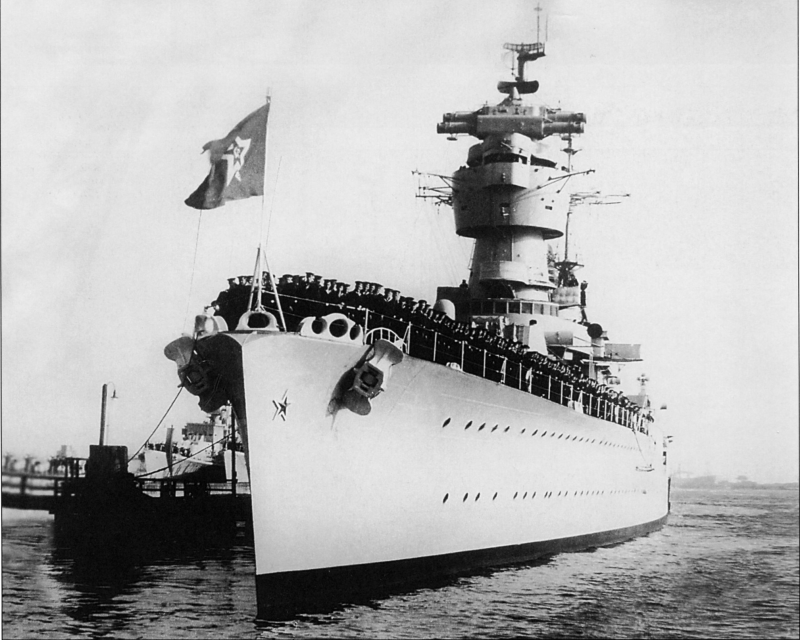
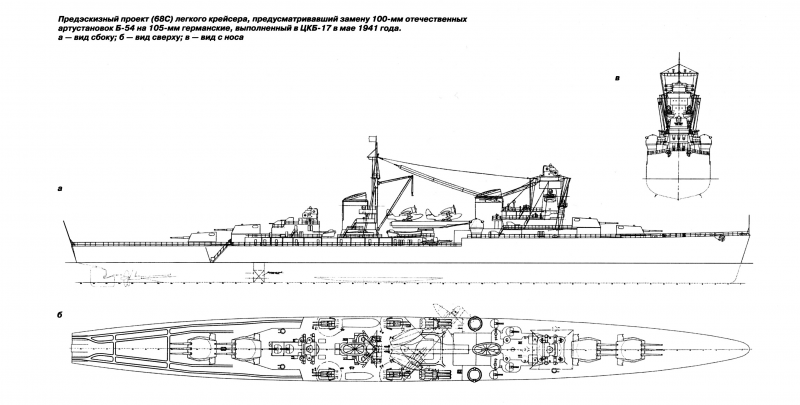
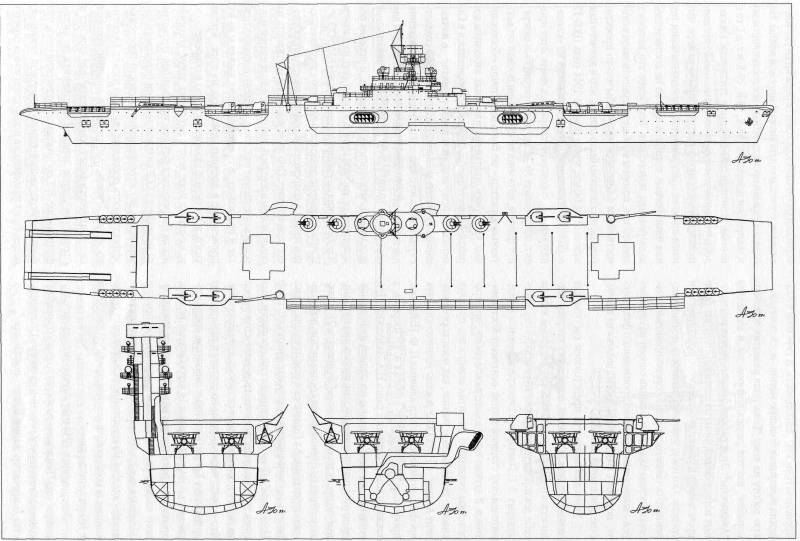
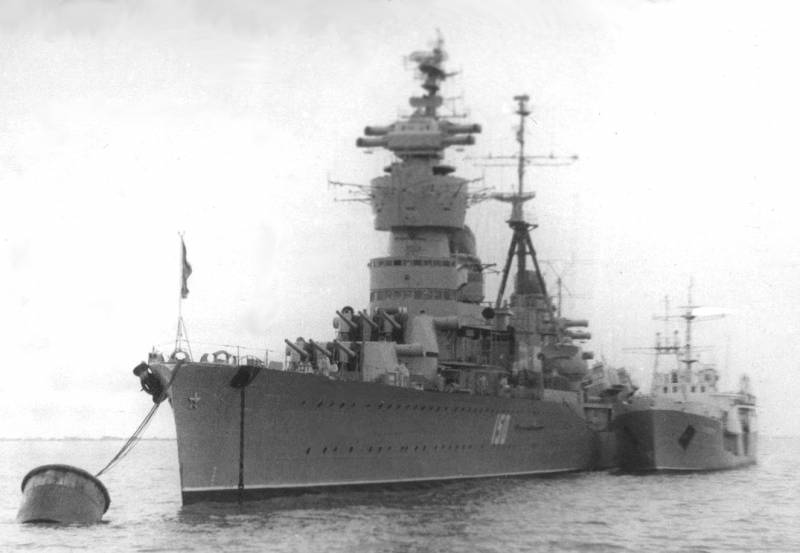
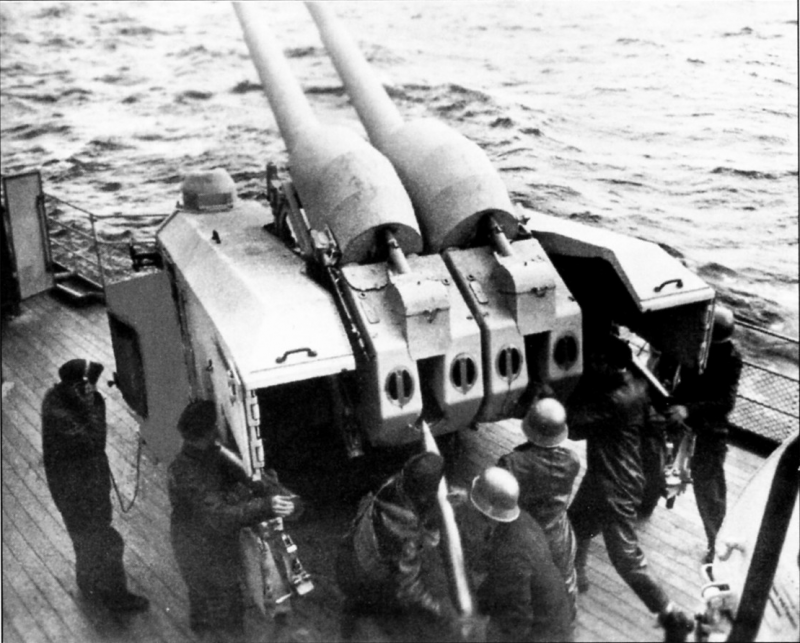

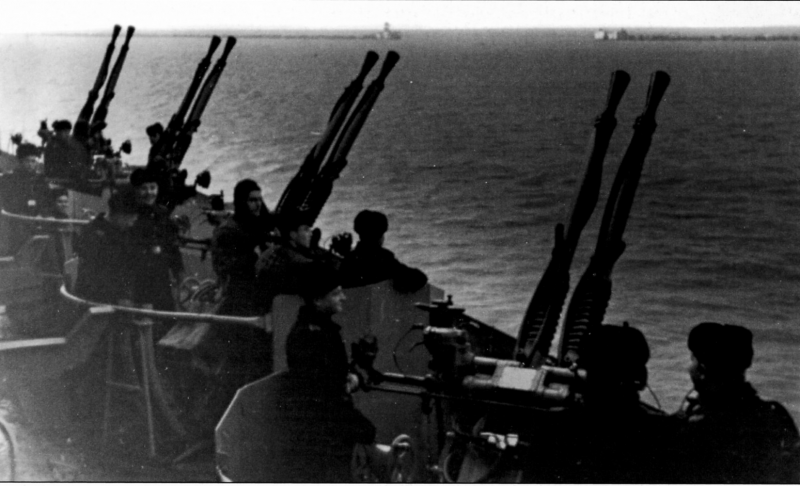
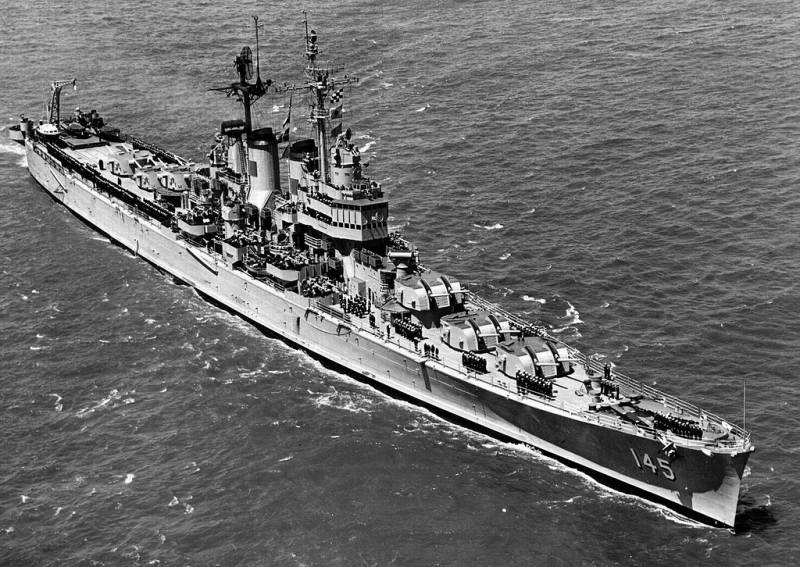
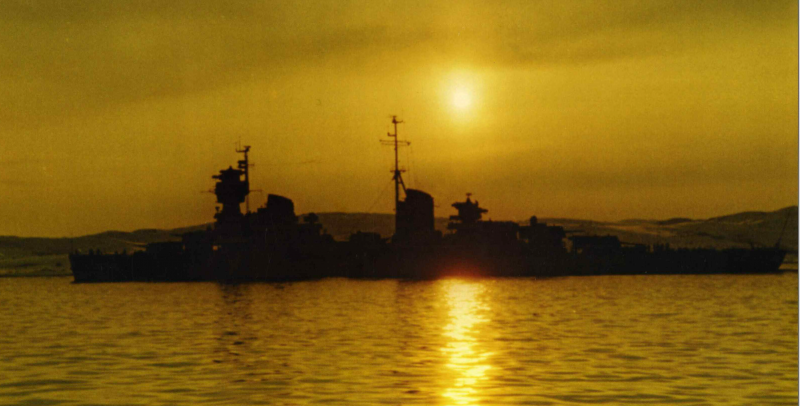
Information